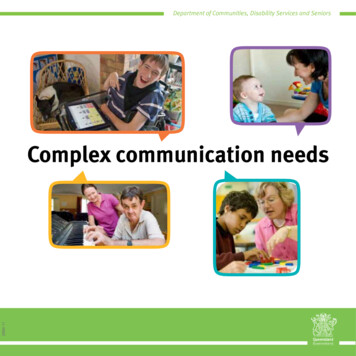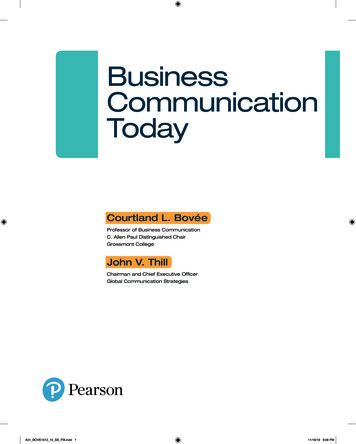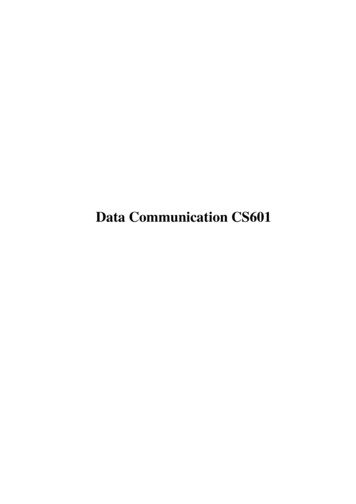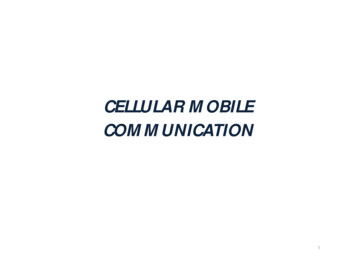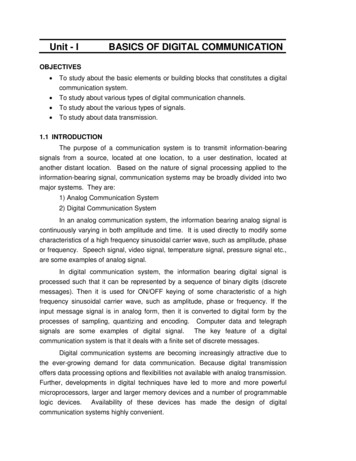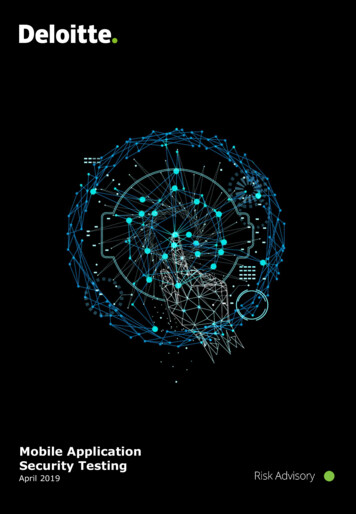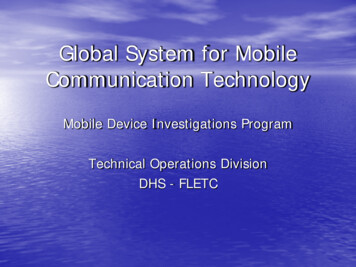
Transcription
Global System for MobileCommunication TechnologyMobile Device Investigations ProgramTechnical Operations DivisionDHS - FLETC
GSM TechnologyGlobal System for Mobile Communication orGroupe Special MobileTo standardize cellular communication thoughoutEuropePrior to it’s development a number of incompatiblesystems served Europe
GSM TechnologyWith GSM, European companies agreed to a set ofstandardsGSM is a open source systemAllows access to codeAll operate based on these standards
GSM TechnologyGSM operates on the 900 MHz, 1800 MHz and 1900 MHzGSM uses Digital Communication System or DCS 1800 andis the worlds main 2G standardWhen the FCC issued 1900 MHz to PCS in the United Statesit was based on GSMDCS 1900 is considered the GSM standard for NorthAmerica and is called North American GSM.
GSM TechnologyGSM is now a worldwide standardGSM uses Time Division Multiple Access or TDMAtechnology as their air interface standardTDMA has limited capabilitiesGSM is strictly controlled by a Memorandum ofUnderstanding (MOU)
GSM Architecture and SubsystemsOpen architecture according to the Open SystemsInterconnect or OSI model for layers 1,2, and 3.Layer 1 – Physical LayerLayer 2 – Data Link LayerLayer 3 – Network LayerGSM carriers can go to any GSM manufacturer
GSM Architecture and SubsystemsGSM uses voice coders/decoders orvocodersVocoders are firmware and chips sets thatdigitize the human voicesVoice that is sampled and channelized ishoused in the vocoder
GSM Architecture and SubsystemsVocoders packetize the sample of the humanspeech and transmits it through the handset tothe base stationDistant-end vocoders decode the pulses androutes the call to the MSCA full-rate vocoder allows for eight (8)conversations over a channelHalf-rate vocoders samples at half the rate ofspeed and allows for more effective use
GSM Architecture and SubsystemsBy standard the GSM network is divided intofour (4) subsystems1.2.3.4.TheTheTheTheBase-Station SubsystemNetwork SubsystemOperation and Support SubsystemMobile Station Subsystem (The Mobile Unit)
Pages 10 through 12 redacted for the following reasons:---------------------------(b)(7)e
Page to be removed
Page to be removed
GSM Subsystems - NetworkSubsystemThe Network Subsystem is in affect the MobileSwitching CenterThe central part of the network.The MSC provides connection to the PublicSwitched Telephone Network (PSTN) and theIntegrated Services Digital Network (ISDN)using SS7 based interconnection.
GSM Subsystems - NetworkSubsystemThe MSC provides subscriber managementfunctions such as;––––mobile registrationlocation updating,authenticationcall routing to roaming subscribers.The Home Location Register (HLR) and the VisitorLocation Register (VLR) are located within theMSC.
GSM Subsystems - NetworkSubsystemThe HLRs database contains different types ofinformation;1. Every Subscriber Identity Module (SIM) card issuedby the Mobile Phone Operator.The SIM has a unique identifier called theInternational Mobile Subscriber Identifier or IMSI,IMSI is a primary key to each HLR.
GSM Subsystems - Network Subsystem2. The SIM card keeps track of all Mobile SubscriberIntegrated Services Digital Network Number orMSISDNs.These are the telephone numbers that have called themobile unit.It is used for making and recieving voice calls andSMS.The MSISDN can have a second number for receivingdata and fax.Each MSISDN is also a primary key in the rationaldatabase.
GSM Subsystems - Network SubsystemExamples of other data stored in the HLR ina SIM record;–GSM services the subscriber has requested or beengiven–General Packet Radio Service or GPRS settingsallow the subscriber access to packet servicesCurrent location of the subscriber; providing aServing GPRS Support Node (SGSN- packet–roaming)– Call Divert or Call Forwarding settings
GSM Subsystems - NetworkSubsystemIn theory the HLR data is stored for as long as thesubscriber is with the mobile phone operatorThe HLR is a systems that directly receives and processesMobile Application Part (MAP) transactions andmessages.If the HLR fails the system fails. The HLR manages theLocation updates as mobile phones roam.The HLR is now a powerful server more so than telephoneswitch hardware
GSM Subsystems - NetworkSubsystemHLR connects and interacts with a number of othercomponents on the system––––The Gateway MSC for handling incoming callsThe VLR for handling request from mobile phonesto attach to the networkThe SMSC for handling incoming SMSThe voice system for delivering notification to themobile phone that a message is waiting
GSM Subsystems - NetworkSubsystemThe main function of the HLR is to manage the movementof SIMs and mobile phones by;––––Managing and updating the position throughlocation areas identified with a Local Call Area(LCA). Updates the users locationSend subscriber information to the VLR when theusers roamsAct as a go between for the GMSC or SMSC with theVLR - receive text or voice messagesRemove the user of the VLR when he/she has leftthat roaming area
GSM Subsystems - Network SubsystemVisitor Location Register (VLR) Database - stores information aboutall the mobiles that are currently under the jurisdiction of theMSCThe most important is the current Location Area Identity or LAI.LAI identifies under which BSC the Mobile Station is currentlyThis information is vital in the call setup process.Whenever an MSC detects a new MS in its network, it creates a newrecord in the VLR,Updates the HLR of the mobile subscriber, apprising it of the newlocation of that MS.
GSM Subsystems - Network SubsystemVLR is a temporary database of the subscribers thathave roamed into the areaEach base Station is served by only one VLRNo one subscriber can be on more that one VLR atany given time.VLR are either linked directly to the V-MSC or areintegrated with a special software interface.
GSM Subsystems - Network SubsystemRelevant data stored there are;–IMSI – the subscriber’s identity number–Authentication Data–MSISDN – the subscriber’s phone number–GSM services the subscriber has access to–Access Points (GPRS) that are subscribed to, and–The HLR address of the subscriber
GSM Subsystems - Network SubsystemThe VLR also connects to;– The Visited MSC (V-MSC), to pass data needed forcertain procedures i.e, authentication and call setup– The HLR to request data for the mobile phonesattached to it’s service area– Other VLR to transfer data as the MS roams from onearea to the next accessing new VLRs
GSM Subsystems - Network SubsystemThe VLR primary functions are– To inform the HLR that a MS has arrived in theparticular area covered by the VLR– To track where the subscriber is within a VLR areawhen it is not active– To validate (allow/disallow) which services thesubscriber may use
GSM Subsystems - Network SubsystemThe VLR primary functions are– To allocate roaming numbers during the process ofincoming calls– To purge the subscribers record if he/she becomesinactive while in its area– To delete the subscribers record when the subscribermoves into another VLRs area based on the rules ofthe HLR. The VLR is reset daily
GSM Subsystems - Network SubsystemOther functions associated with the Network Substation are; The Authentication Center - provides authentication of the MSand encryption of services The Equipment Identity Register (EIR) – Using the IMSI, theEIR keeps track of valid MS. If one is lost, stolen or servicediscontinued it is blacklisted on the EIR Billing Center (BC) – produces the tolls generated by the VLRand HLR for each subscriber and the roaming data Short Message Service Center (SMSC) – the sending andreceiving of short messages
Page 28 redacted for the following reason:--------------------(b)(7)e
GSM Subsystems Operations and SupportSubsystemThe Operations and Support Subsystem – thecommand and control center used to monitor theGSM system.If there is a particular system failure the OSS canidentify the problem and determine what courseof action is needed
GSM Subsystems - Mobile StationSubsystemThe Mobile Station (Mobile Phone) Subsystem –also known as the User Equipment. GSM phonesare segmented for a number of reasons.The MS has four main components;1.2.3.4.The Mobile TerminalThe Terminal EquipmentTerminal AdapterSubscriber Identity Module or SIM
GSM Subsystems - Mobile StationSubsystemThe Mobile Terminal or Handset – identificationinformation is held on the SIM cardThe handset’s main functions are to transmit, receive,encode and decode voice transmissions.The SIM card contains the GSM operating program,customer and carrier specific data.
GSM Subsystems - Mobile StationSubsystemProgrammed at the sales office, the SIM cardprovides authentication, information storage,subscriber account information and dataencryption.SIM cards and handsets are interchangeable.SIM card will recall all information stored on it,including programmed numbers, SMS saved, ringtones, Contact list and the like.
GSM Subsystems - Mobile StationSubsystemSome of the Network Specific items used to authenticate andidentify subscribers on the Network are;Integrated Circuit Card ID or ICCID – International ID,stored in the SIM card and stamp of the cardInternational Mobile Subscriber Identity or IMSI- Mobileoperators connect mobile phone calls and communicatewith their market through SIM cardsLocal Area Identity or LAI – Networks are divided into localareas with a unique number. When you travel from onearea to another the unique number is logged in the SIM.
GSM Subsystems - Mobile StationSubsystemOperator Specific Emergency Number – like “112” or E911these numbers (5) are programmed into the SIMShort Message System Center Number or SMSC number –the number used to sent text messagesService Providers Name or SPN – the telecommunicationsservice providers name and IDService Dialing Numbers or SDN – numbers associated withthe service provider
GSM Subsystems - Mobile StationSubsystemAdvice of Charges – what are the parameters in which theaccount will chargedValue Added Services or VAS – what type of service i.e.Internet access is associated with the accountDepending on storage capacity any type of data may bestored.In Europe some subscribers store their medical records ontheir SIM card.Any data!!!!!!!
GSM Subsystems - Mobile Station SubsystemAuthentication Key or Ki – a 128-bit value used toauthenticate the SIM to the mobile network. Assignedby the operator the Ki is contained on the serviceproviders HLR.GSM was designed from the start with security in mind. TheSIM card aids in this security, making fraud on a GSMnetwork unlikely.Using a series of secret keys and algorithms thwarted cloningof GSM devices.
GSM Subsystems - Mobile StationSubsystemIn GSM Call Handoff, or Call Handover is differentin that it is mobile device assisted.The mobile phone continually monitors base stationsin vicinity measuring the strength in the MSC.The six best prospects are sent back to the MSC whothen determines when the handoff will beconducted.
GSMOften described as a true Intelligence Network, GSM iscalled the first true wireless network because; It has an open, distributed architectureThe separation of switching and service controlfunctionsFull use of SS7 as the signaling infrastructureIts clearly defined and specified interfacesThe nature of its IN structureGeneral Packet Radio Service (GPRS) and Enhanced DataRates for Global Evolution (EDGE - CDMA), are 3GGSM based standards
GSM Adjunct SystemsGSM standards define that certain Adjunct or SecondarySystems work with GSM technology. Some of note are; The Gateway MSC or GMSC – The purpose of which isto query the HLR and determine the location of thesubscriber. Calls from another network i.e. PSTN willfirst go through the GMSC. Short Message Service Center or SMSC – The node thatstores and forwards short messages to and from themobile station.
GSM Adjunct Systems The Equipment Identity Register or EIR –identifies what equipment i.e. handsets areacceptable in a GSM Network The Interworking Function or IWF – used forcircuit switched data and fax services. It isbasically a modem bank
GSM v CDMAThere is a debate as to how long TDMA or IS-136 cellphones will be in existence. GSM and CDMA systemnow dominate the market.Both work well on their own as well as with each other.Some CDMA mobile units use a Removable – User IdentityModule or R-UIM which is similar to a SIM. There areDual R-UIM that allow for use in both GSM and CDMAunits.Both seem positioned to be in place for a period of time.
GSM Often described as a true Intelligence Network, GSM is called the first true wireless network because; It has an open, distributed architecture The separation of switching and service control functions Full use of SS7 as the signaling infrastructure Its clearly defined and specified interfaces The nature of its IN structure






